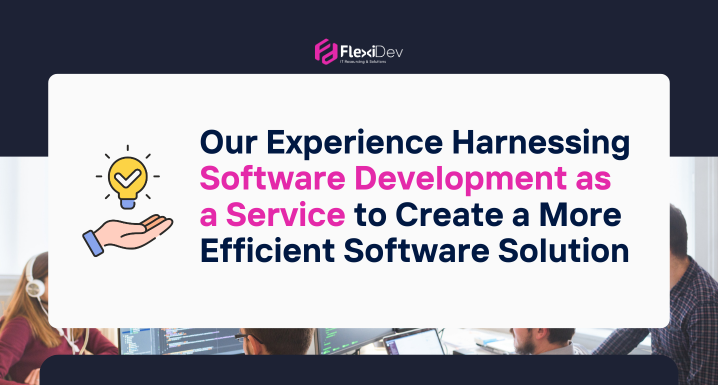
This article describes how, several years ago, our company revolutionised a number of our core reporting systems. The impetus for this transformation was that FlexiDev had been developing HR-focused software for various clients, including Customer Relationship Management (CRM) and Enterprise Resource Planning (ERP) platforms. During the development of an ERP for a restaurant chain, we realised there was an opportunity to upgrade our own internal technology. After further investigation, we discovered that with a moderate development investment, we had everything needed to create an ERP that could significantly reduce our operational costs.
The Process
We decided to dedicate internal resources, and this meant the development schedule had to be tight. As a result, we required a development model that would allow us to allocate developer resources flexibly, while continuing to meet our obligations to client projects. Software Development as a Service (SDaaS) became the obvious choice. It allowed us to scale up or down based on need, onboard different technology expertise when required for specific components, and then directly revert to the original development team setup once those specialised components were finalised. This flexibility brought together several tech disciplines, resulting in the completion of our current ERP system.
The main advantage of utilising SDaaS was to ensure the delivered product aligned with our technical and project requirements. It offered the right blend of development expertise and flexibility in resource allocation, as our goal was to avoid being locked into a single team or technology stack and to engage developers that would integrate seamlessly into the pre-existing team. Through continuous collaboration and feedback loops, we could make sure the development process moved forward efficiently and that any emerging bottlenecks were promptly addressed.
The Why
The choice to leverage SDaaS was not just about managing tight timelines. It was also about minimising long-term operational costs while enhancing scalability and adaptability. Traditional development models require long-term commitment to staff, often leading to inefficiencies when those staff are underutilised. SDaaS, however, gave us access to specialised talent when we needed it, allowing us to save costs during slower periods while accelerating development when workloads increased. You see, when you take on an SDaaS resource even for only a very short development stint on your project, you can then pick up the same development resources at a later point. This is because FlexiDev’s developers are all full-time employed team members. Those developers will also have experience of implementing similar technology, ensuring greater accuracy and choice of the most efficient solutions.
SDaaS offers several qualities that makes it particularly attractive for companies wishing to refresh their current systems. First, it provides on-demand access to a diverse pool of technical talent. You can onboard developers with niche skills, or UX/UI design for specific stages of development. Second, SDaaS promotes agility in development workflows. For our team as we worked through iterations of our ERP system, we could rapidly integrate feedback and adjust our development trajectory without significant delays or resource waste. Finally, SDaaS operates on a pay-as-you-use model, which reduces overhead costs and allows for more precise budget allocation.
Problems Solved
One of the key challenges we encountered with our previous software solution was access to control over processes. It has become clear over the years since introducing the new ERP how timely getting that sorted at that moment was. Having greater control over how we organise our teams and transactions has afforded our team the freedom to make changes within the organisation which we could not have easily done otherwise. The enhanced reporting capabilities have also been a vast improvement. We are now able to generate detailed, real-time reports, providing better insights into our operations and enabling more informed decision-making. This level of transparency across departments wasn’t possible before, and it has helped align our teams with organisational goals. And, of course, these changes were implemented with rigorous security protocols over all data exchanges.
The new system has significantly reduced bottlenecks in our workflow by automating several previously manual tasks. This has led to noticeable improvements in efficiency, allowing teams to focus on more strategic initiatives rather than getting bogged down by administrative duties. For example, our finance department no longer has to spend hours reconciling accounts manually, as the ERP automates much of that process, drastically cutting down processing times and reducing errors. In a similar regard, it is far more straightforward with our current software system if we should choose to do any further revision. The technology is in line with industry standards, meaning we can easily upgrade or alter the flow without a large development outlay. With the flexibility and scalability of the new ERP system, we can adapt to the changing needs of the business and as we continue to grow, we can integrate new modules and functionalities without disrupting our existing operations. This ensures that our software continues to evolve as we do, giving us the confidence to plan for long-term expansion.

Your Options
When exploring SDaaS providers, you should keep in mind several factors:
- Do they have full-time development staff? The benefits of this are that the developers you utilise will be part of greater teams that enjoy the perks of knowledge sharing, and regular quality standards reviews. You will also avoid any costly recruitment processes.
- Do they offer flexibility in the allocation of the resources you are using? You must be able to scale up and scale down as your project progresses. And the SDaaS vendor should be responsible for the contractual obligations when you alter your developer resource allocation.
- Do they have a proven track record of completed projects. This allows you as a business to identify the development scenario that best fits your timeline and needs, through comparison with similar projects that have been realised previously by the SDaaS vendor.
- Lastly, what level of support do they offer? As our team is full-time and benefits from insights from several very experienced seniors within their teams, you can rely on communication that is clear, responsive and your developers will update you frequently on task progress. This is crucial in development to verify that the features that are developed are the features that are required, and being informed of project updates means your team can make decisions based on the here and now. FlexiDev is agile and clear communication is our priority.
Overview
The decision to utilise SDaaS was pivotal in enabling us to transform our internal systems while continuing to serve our clients effectively. SDaaS provided us flexibility, scalability and cost-efficiency, and in embracing this approach we successfully built an ERP system that reduced our operating costs and improved internal workflows And this helping us maintain a competitive edge. For companies looking to innovate without overextending their resources, SDaaS offers a powerful development model that can adapt to a range of technology and business needs. Our development consultation team are always available to help give some insights into how you can grow with tailored technology solutions. Simply drop us a line today.



